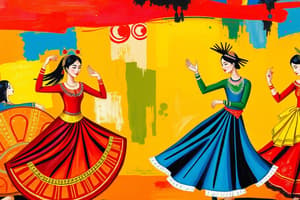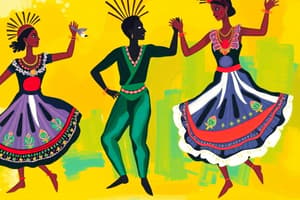Podcast
Questions and Answers
What do Philippine folk dances convey about the Filipino people?
What do Philippine folk dances convey about the Filipino people?
Customs, ideas, beliefs, superstitions, and daily life events within a community
What do the costumes, props, and instruments used in a dance reveal?
What do the costumes, props, and instruments used in a dance reveal?
The origin of the dance and the influences of neighboring countries
What is characteristic of the Binislickin dance, and what does it signify?
What is characteristic of the Binislickin dance, and what does it signify?
The use of sticks (Bislak) to signify Chopsticks
What is the significance of the white fans used in the Saku dance?
What is the significance of the white fans used in the Saku dance?
What are the characteristics of the Saku dance music?
What are the characteristics of the Saku dance music?
What is distinctive about the Pangalay dance costume?
What is distinctive about the Pangalay dance costume?
What is the common thread among the national folk dances studied by Francisco Reyes Aquino?
What is the common thread among the national folk dances studied by Francisco Reyes Aquino?
What instruments are used to gather peasants before they start to work in the Ticklows dance?
What instruments are used to gather peasants before they start to work in the Ticklows dance?
What is the significance of the term 'Securing' in the context of the dance from Abra and Ilocos Norte?
What is the significance of the term 'Securing' in the context of the dance from Abra and Ilocos Norte?
What is the typical attire for female dancers in the Securing dance?
What is the typical attire for female dancers in the Securing dance?
Flashcards are hidden until you start studying
Study Notes
- Philippine folk dances reflect the heartbeat of the Filipino people, conveying customs, ideas, beliefs, superstitions, and daily life events within a community.
- The costumes, props, and instruments used in a dance reveal the origin of the dance and the influences of neighboring countries, such as China, Malaysia, Indonesia, Burma, Cambodia, Thailand, and Japan.
- The dance researcher Francisco Reyes Aquino studied the historical backgrounds and contexts of various regional and national folk dances, including Binislickin, Saku, Suaku, Pangalay, Ticklows, and Securing.
- Binislickin is a social dance from Lingayan, Pangasinan, with Chinese influences, characterized by the use of sticks (Bislak) to signify Chopsticks.
- The dance costume for females includes a sea-green kimono with loose and long sleeves and a soft panuelo, while males wear a camisa de Chino and red pants.
- The Binislickin dance music is composed of two parts (A and B) with a count of 1-2-1-2 and 1-and-2.
- Saku is a courtship dance from Jolo, Sulu, with influences from China, Malaysia, and Indonesia, characterized by the use of white fans to represent the rustling of leaves.
- The dance costume for females includes a traditional loose blouse with a deep plunging keyhole neckline and loose Chinese pants with a 10-inch soft white band, while males wear a short waist collarless shirt and darker pants with bolder designs.
- The Saku dance music is composed of two quarters and four quarters, with a count of 1-2-to-a-measure in two quarters and 1-2-3-4-to-a-measure in four quarters.
- Pangalay is a wedding festival dance from Sulu, with influences from Thailand, Malaysia, Burma, Cambodia, and Indonesia, characterized by the use of extended metal fingernails (Jangay) and martial arts movements.
- The dance costume includes a typical Hollowayn costume, with dancers wearing bare feet and using jangay made of solid gold or silver.
- Ticklows is a recreational dance from Pinay and Leyte, with influences from China, Burma, and Cambodia, characterized by the use of flutes, guitars, and gimbal or tambora to gather peasants before they start to work.
- The dance costume includes working costumes, with the music divided into two parts (A and B) and a count of 1-2 or 1-2-2.
- Securing is a recreational and social dance from Abra and Ilocos Norte, with influences from China, characterized by the use of rhythmic sticks to produce the accompaniment for the dance.
- The dance costume includes a native Ilocano kimono-style dress with bright colored plaids and a native hat for females, and a camisa de Chino and red trousers for males.
- Securing is an ethnic term that refers to the rhythmic sticks producing the accompaniment for the dance, which is often performed during Christmas time to ask for gifts.
Studying That Suits You
Use AI to generate personalized quizzes and flashcards to suit your learning preferences.




